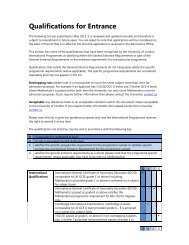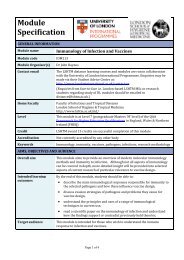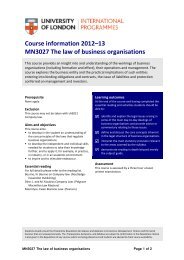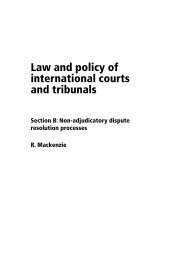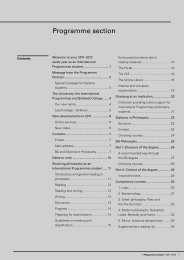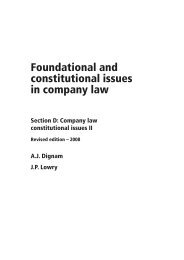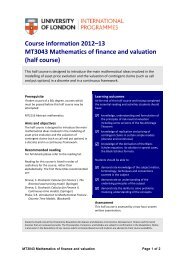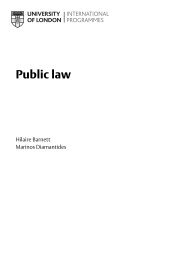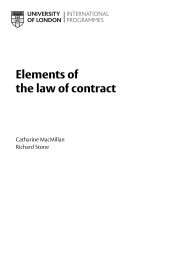Introduction to computer systems architecture and programming
Introduction to computer systems architecture and programming
Introduction to computer systems architecture and programming
Create successful ePaper yourself
Turn your PDF publications into a flip-book with our unique Google optimized e-Paper software.
168 <strong>Introduction</strong> <strong>to</strong> <strong>computer</strong> <strong>systems</strong> <strong>architecture</strong> <strong>and</strong> <strong>programming</strong><br />
• develop an underst<strong>and</strong>ing of the underlying structure <strong>and</strong> theories of<br />
<strong>computer</strong>s <strong>and</strong> <strong>programming</strong><br />
• provide the skills needed <strong>to</strong> develop algorithms for <strong>programming</strong><br />
solutions<br />
• provide the skills needed <strong>to</strong> write simple programs in Java.<br />
Learning outcomes<br />
At the end of the course, <strong>and</strong> having completed the Essential reading <strong>and</strong><br />
activities, you should be able <strong>to</strong>:<br />
• identify the basic elements of hardware <strong>and</strong> explain their functions <strong>and</strong><br />
how they fit <strong>to</strong>gether <strong>to</strong> form an <strong>architecture</strong><br />
• explain how data is represented, manipulated <strong>and</strong> s<strong>to</strong>red within a<br />
<strong>computer</strong> system<br />
• identify <strong>and</strong> explain the functions of operating <strong>systems</strong><br />
• explain how <strong>computer</strong>s interact through local <strong>and</strong> wide area networks<br />
• identify various different types of <strong>programming</strong> languages <strong>and</strong><br />
appreciate how they have evolved since the early days of <strong>computer</strong><br />
<strong>programming</strong><br />
• design algorithms <strong>to</strong> solve basic <strong>programming</strong> problems<br />
• explain common data types <strong>and</strong> structures<br />
• explain basic <strong>programming</strong> structures<br />
• explain the underlying concepts of object-oriented <strong>programming</strong><br />
• write simple but effective programs in Java.<br />
2<br />
How <strong>to</strong> use this subject guide<br />
The aim of this subject guide is <strong>to</strong> help you <strong>to</strong> interpret the syllabus. It<br />
outlines what you are expected <strong>to</strong> know for each area of the syllabus <strong>and</strong><br />
suggests relevant readings <strong>to</strong> help you <strong>to</strong> underst<strong>and</strong> the material.<br />
Throughout this guide I will point you <strong>to</strong>wards reading in two main<br />
textbooks. I would recommend that you work through the guide in chapter<br />
order, reading the essential texts in parallel. You will find that much of<br />
the information you need <strong>to</strong> learn <strong>and</strong> underst<strong>and</strong> can also be found on<br />
the internet <strong>and</strong> in other texts, some of which are listed below. I find that<br />
different students prefer different writing styles <strong>and</strong> underst<strong>and</strong> certain<br />
texts better than others. Although you must read the Essential reading, I<br />
would encourage you <strong>to</strong> look at other sources, <strong>to</strong>o, where you might find a<br />
slightly different explanation/discussion of the same <strong>to</strong>pic helpful.<br />
Each chapter of this subject guide also provides you with examples <strong>and</strong><br />
activities. It is important that you go through the examples carefully <strong>and</strong><br />
make sure you have unders<strong>to</strong>od them fully. The activities are also an<br />
important part of this course. They ensure that you practise the material<br />
covered <strong>and</strong> help you <strong>to</strong> check whether you have unders<strong>to</strong>od important<br />
parts of the <strong>to</strong>pic. The examination paper will be set based on the<br />
assumption that you have completed all of the activities in this guide.<br />
Having said this, it is important that you appreciate that different <strong>to</strong>pics<br />
are not self-contained. There is a degree of overlap between them <strong>and</strong><br />
you are guided in this respect by the cross-referencing between different<br />
chapters. In terms of studying this subject, the chapters of this guide are<br />
designed as self-contained courses of study, but for examination purposes<br />
you need <strong>to</strong> have an underst<strong>and</strong>ing of the subject as a whole.



